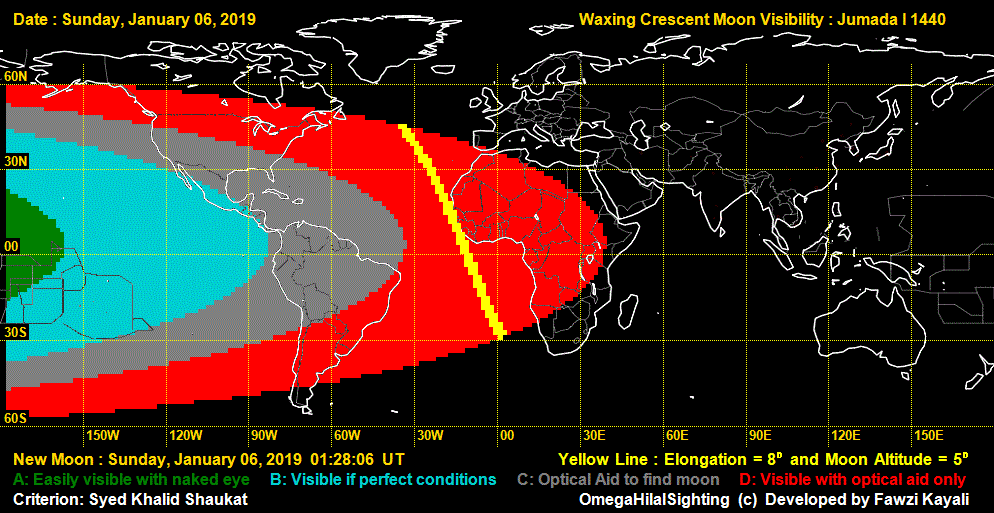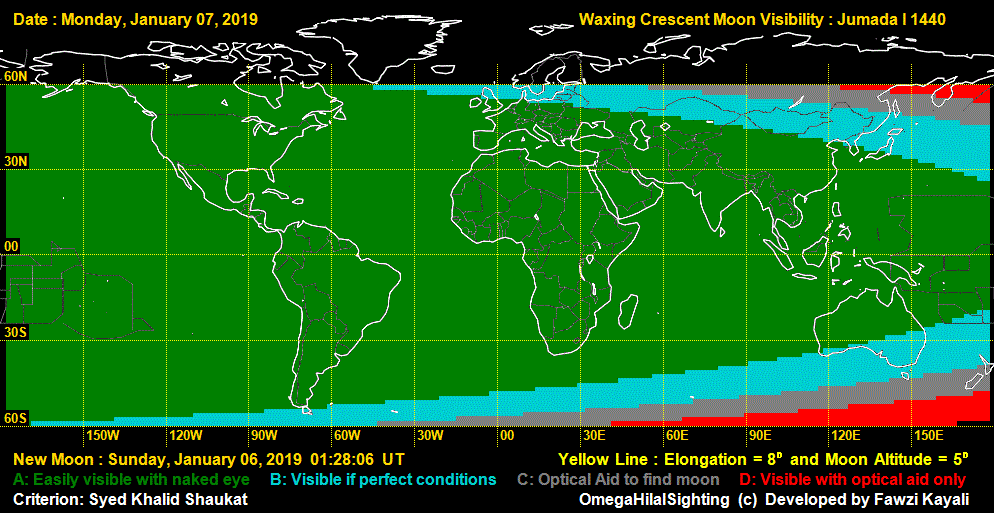MAKKAH – Muslims all over the world celebrate today, January 7, the start of the new Hijri month Jumada Al Awwal, the fifth Hirji month of the Hijri calendar 1440.
According to the National Research Institute of Astronomy & Geophysics (NRIAG) in Helwan, Egypt, the Astronomical New Moon (conjunction) occurred on January 6, 2019, at 1:28 UTC. On that day, there was no possibility to see the new crescent except by telescope in the Americas.
Today on January 7, the moon can be easily seen in the whole world except New Zealand according to Moonsighting.com.

Map of January 6
The Hijri Calendar is a lunar one, meaning that months begin when the first crescent of a new moon is sighted. And since this type of calendars is 11 to 12 days shorter than the solar year, Jumada Al Awwal and all Hijri months migrate throughout the seasons.
As observed from earth, the lunar phase is the shape of the luminous portion of the moon. Moon phases change as the Moon orbits the Earth, according to the changing positions of the Moon and Sun.
The eight principal and intermediate phases which take place during a Hijri month are, in sequential order: New Moon, Waxing Crescent, First Quarter, Waxing Gibbous, Full Moon, Waning Gibbous, Last Quarter, and Waning Crescent.
The lunar terminator is the boundary between the luminous and dark hemispheres. Each of the four “intermediate” lunar phases is roughly seven days. Yet, this varies slightly due to the elliptical shape of the Moon’s orbit.
The moon travels the same path all year round. When we see it in the east, we see it traveling towards the west. Any country sees the moon within a 24-hour period once spotted by its eastern neighbor.
Al Ro’ya Day: How to Observe?
For naked eye observation of the crescent as prescribed in Islamic Shari’ah, you need an open western horizon. The site must have a clear sky and an above-sea-level altitude.
The observer should go to the observing site on the 29th of the Hijri month. Then the observer has to look for the crescent at the west during sunset.
If the observer sees the crescent, this automatically means that new Hijri month has started, while if the observer doesn’t see the crescent this means that the next day will be the 30th and last day of the current month.
The crescent must be obvious after the sun sets. Otherwise, if the observer noticed the crescent with the naked eye before sunset –almost impossible- he wouldn’t count that as the crescent of the first day of a lunar month.
If the observer sees the crescent having its horns facing downwards, this would mean the observer has seen the Waning Crescent which is the crescent of the end of a lunar month.
Hence, a lunar month must start with a “Waxing Crescent” which is the correct crescent of the beginning of the lunar month with its horns facing upwards.

